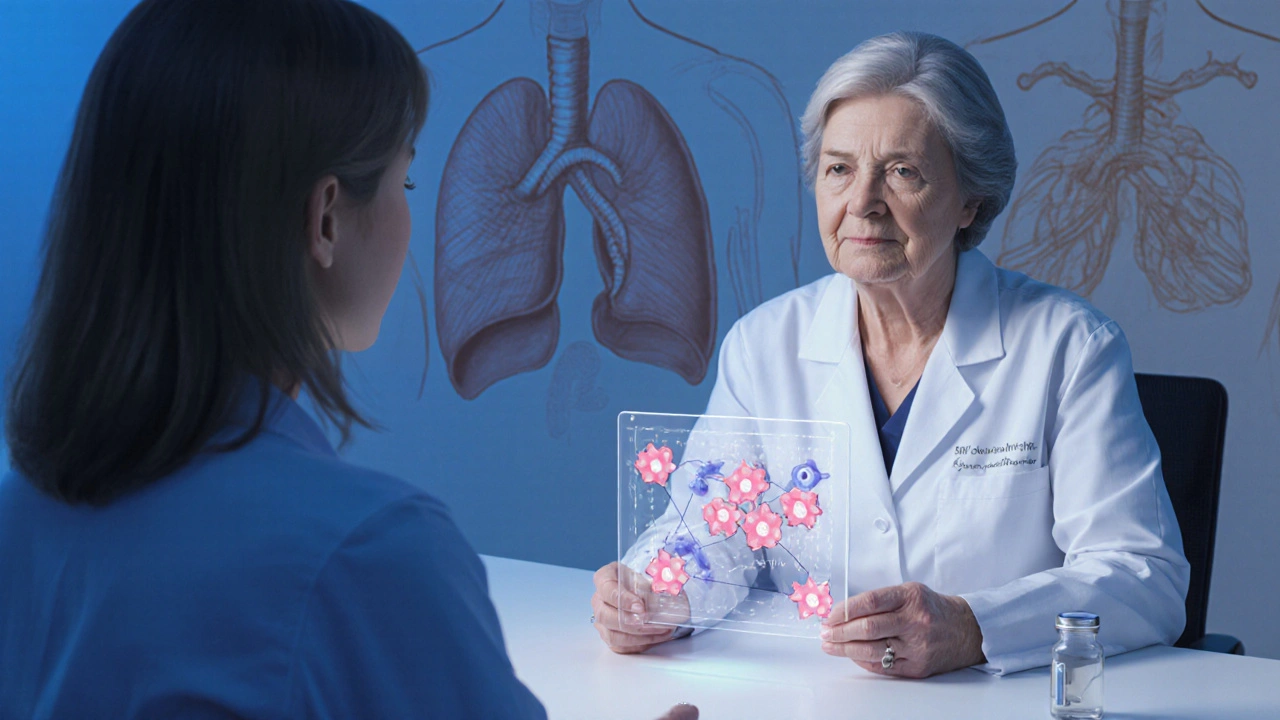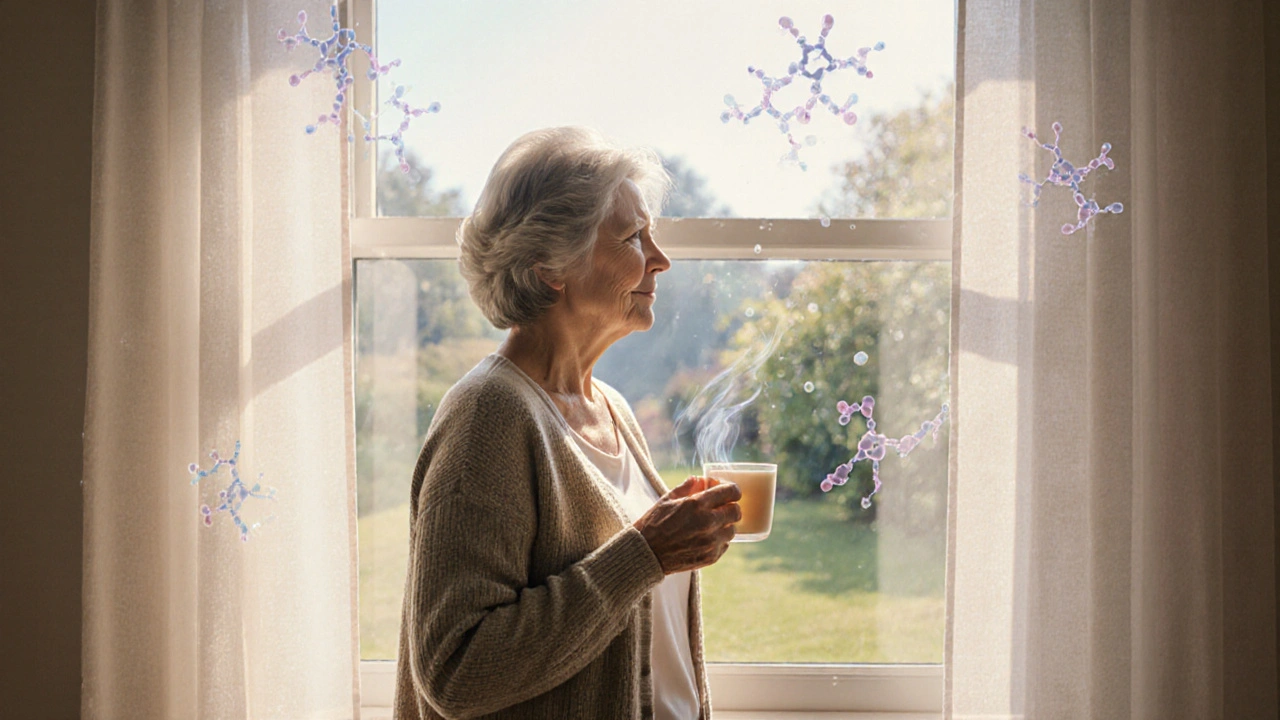Menopause & Breast Cancer Risk Calculator
Age at Menopause
Early menopause (<50) vs. Normal menopause (50-55) vs. Late menopause (>55)
Hormone Replacement Therapy (HRT)
Type and duration of HRT use
Lifestyle Factors
Weight, alcohol consumption, and physical activity
Family History
Inherited genetic risk factors
Your Personalized Risk Estimate
Recommendations:
Ever wonder whether the changes your body goes through in your 50s could affect your chances of developing breast cancer? menopause brings a cascade of hormonal shifts, and those shifts can reshape the risk landscape for many women. Below we break down what the science says, where the biggest risk drivers hide, and what practical steps you can take right now.
Quick Takeaways
- Natural menopause slightly lowers estrogen‑driven breast cancer risk, but the overall risk still rises with age.
- Hormone replacement therapy (HRT), especially combined estrogen‑progestogen, can increase risk by 20‑30%.
- Regular mammography screening remains the most effective early‑detection tool after 50.
- Maintain a healthy weight, limit alcohol, and stay active to offset hormonal influences.
- Family history and genetic markers (BRCA1/2) matter more than menopause timing.
What Is Menopause?
Menopause is the permanent cessation of menstrual cycles, marking the end of a woman's reproductive years. It typically occurs between ages 45 and 55, with the average age in Australia at 51years. The transition, often called perimenopause, can last several years and is characterized by fluctuating levels of estrogen and progesterone.
How Breast Cancer Develops
Breast cancer is a malignant growth arising from breast tissue cells, most commonly the ducts or lobules. About 1 in 8 Australian women will be diagnosed in their lifetime, with risk factors spanning genetics, hormones, lifestyle, and age.

Hormonal Shifts and Their Impact on Risk
Estrogen fuels many breast cancers by binding to estrogen receptors on cells, promoting growth. During the reproductive years, estrogen levels rise and fall each month. When menopause arrives, circulating estrogen drops dramatically, which on its own reduces the stimulation of potential cancer cells. However, the overall risk of breast cancer still climbs with age because older cells have had more time to accumulate DNA damage.
Key hormonal players:
- Estrogen - the main driver of cell proliferation in estrogen‑receptor‑positive tumors.
- Progesterone - can augment estrogen’s effect, especially when both are given in hormone therapy.
Hormone Replacement Therapy (HRT) and Breast Cancer
Many women turn to Hormone Replacement Therapy (often abbreviated HRT) to tame hot flashes, night sweats, and vaginal dryness. The therapy comes in three main forms:
- Estrogen‑only (for women without a uterus).
- Combined estrogen‑progestogen (for women with an intact uterus).
- Local vaginal estrogen (minimal systemic absorption).
Large cohort studies, such as the Women’s Health Initiative (WHI), show that combined HRT raises breast‑cancer incidence by about 20‑30% after five years of use, while estrogen‑only therapy shows a modest, non‑significant increase. The risk appears to fade after stopping therapy, but the latency period can be up to a decade.
Screening Recommendations After Menopause
Age‑based mammography remains the gold standard. Australian guidelines advise:
- Women aged 50‑74: a mammogram every two years (or annually if high risk).
- Women with a strong family history or known BRCA mutation: start yearly screening at 40, possibly supplemented with MRI.
For women on HRT, clinicians often suggest a baseline mammogram before starting therapy and more vigilant annual checks thereafter.
Other Major Risk Factors That Overshadow Menopause Timing
| Factor | Relative Risk Increase | Modifiable? |
|---|---|---|
| Early menarche (<12y) / Late menopause (>55y) | 1.3‑1.5× | No |
| Family history (first‑degree) | 2‑3× | No |
| BRCA1/2 mutation | 5‑10× | No |
| Combined HRT (≥5y) | 1.2‑1.3× | Yes (choose alternative) |
| Obesity (BMI≥30) | 1.2‑1.4× | Yes |
| Alcohol (>10g/day) | 1.1‑1.2× per drink | Yes |
Notice that genetics and lifestyle often dwarf the modest influence of menopause timing itself.

Practical Steps to Lower Your Risk During and After Menopause
- Stay active. Aim for at least 150minutes of moderate exercise weekly; research ties regular activity to a 10‑15% risk drop.
- Watch your weight. Post‑menopausal women gain abdominal fat, which can raise estrogen levels via aromatization. Keeping BMI under 25 is linked with lower incidence.
- Limit alcohol. No more than one standard drink per day; each extra drink adds roughly 7% risk.
- Consider diet. A Mediterranean‑style diet rich in fruits, vegetables, whole grains, and healthy fats shows a modest protective effect.
- Re‑evaluate HRT. If you need relief, discuss the lowest effective dose, shortest duration, and possibly estrogen‑only options if you’ve had a hysterectomy.
- Stick to screening. Book your mammogram and keep a log of results. Bring any family‑history updates to your GP.
Common Myths Debunked
- Myth: Menopause guarantees you’ll get breast cancer.
Fact: Risk rises with age, but menopause itself does not cause cancer. - Myth: If I stop HRT, my risk goes back to normal instantly.
Fact: The increased risk fades over several years after cessation. - Myth: Natural remedies are safer than HRT.
Fact: Some herbal supplements can interact with medications and have unknown estrogenic effects.
When to Seek Professional Advice
If you notice any new breast changes-lumps, skin dimpling, nipple discharge-contact a health professional promptly, regardless of age. Additionally, schedule a genetics consultation if you have multiple first‑degree relatives with breast or ovarian cancer.
Frequently Asked Questions
Does menopause increase my chance of getting breast cancer?
Age‑related risk rises as you get older, but the drop in estrogen during menopause actually lowers the hormone‑driven component of risk. Overall, the net effect is a modest increase due to aging, not menopause itself.
Should I stop taking HRT because of breast cancer worries?
Talk to your GP. If your symptoms are severe, low‑dose or estrogen‑only options may be viable. The goal is to balance quality‑of‑life benefits with a small, manageable risk increase.
How often should I get a mammogram after 50?
Australia recommends a mammogram every two years for women 50‑74. If you have high‑risk factors-family history, BRCA mutation, or long‑term HRT-your doctor may suggest an annual screen.
Can diet really affect breast cancer risk after menopause?
Yes. Studies show that a diet rich in fiber, antioxidants, and healthy fats can lower estrogen levels and inflammation, both of which are linked to reduced breast‑cancer risk.
Is a family history more important than my menopause status?
Definitely. A first‑degree relative with breast cancer roughly doubles your risk, far outweighing the modest impact of menopause timing.


14 Comments
Joery van Druten
October 7, 2025 AT 13:45When looking at the risk factors, the hormonal shift after menopause is just one piece of the puzzle. The drop in circulating estrogen does reduce the estrogen‑driven proliferation in breast tissue, but age‑related DNA damage still accumulates. Keeping a healthy weight and limiting alcohol are practical steps that have solid evidence behind them. Regular mammograms remain the cornerstone of early detection, especially after 50. These lifestyle tweaks can modestly shift the risk curve in a favorable direction.
Melissa Luisman
October 8, 2025 AT 14:19The claim that HRT "only" adds a tiny risk is misleading. Studies like the WHI show a clear 20‑30% increase with combined estrogen‑progestogen therapy after five years. Ignoring that fact does a disservice to women who might otherwise skip a safer alternative. Also, the article downplays the significance of family history compared to hormonal factors-genetics remains the dominant driver. Readers deserve the full picture, not a sugar‑coated version.
Akhil Khanna
October 9, 2025 AT 14:53Hey folks, just wanted to add that staying active isn't just about weight loss – it actually helps regulate estrogen levels even after menopause 🙌. Also, don't forget that a plant‑based diet can lower inflammation which is linked to lower breast‑cancer risk. I've seen many friends benefit from daily walks and they report feeling more energetic. 😊
Zac James
October 10, 2025 AT 15:26It's worth noting that cultural attitudes toward menopause can influence how women perceive risk. In some societies, the transition is celebrated, which may reduce stress‑related hormonal spikes. Stress management, alongside the usual lifestyle changes, can be a subtle but important factor. Keeping an open dialogue with healthcare providers ensures personalized advice.
Arthur Verdier
October 11, 2025 AT 16:00Oh sure, the big pharma wants you to believe that a few pills will keep you forever young, but have you ever considered the hidden agenda? They pump out hormones and then sit back while the data gets buried. The so‑called "combined HRT" is just a marketing gimmick to keep the profit wheels turning. If you’re smart, you’ll question the narrative and look for natural alternatives.
Breanna Mitchell
October 12, 2025 AT 16:34Keeping a positive outlook can actually make a difference. When you stay active, eat well, and stick to screening schedules, you empower yourself against uncertainty. Remember, every small step-like swapping a sugary drink for water-adds up over time. Celebrate those wins; they’re the building blocks of long‑term health.
Alice Witland
October 13, 2025 AT 17:08While the science is solid, it never hurts to sprinkle a bit of sarcasm on the obvious. Yes, menopause lowers estrogen, but it doesn’t magically erase decades of cellular wear and tear. The real hero here is regular screening-no amount of diet trivia can replace a good mammogram. So, keep the jokes light and the appointments on schedule.
Chris Wiseman
October 14, 2025 AT 17:41Consider, if you will, the tapestry of existence where each thread represents a hormonal whisper in the grand loom of life. Menopause, that inevitable cessation of cyclic estrogen, is but a single stanza in the epic poem of aging. Yet the poem does not end there; the verses of genetic destiny-BRCA1, BRCA2-compose a chorus that resonates louder than any fleeting hormonal crescendo. When we pivot our gaze toward the microscopic realm, we see that cellular senescence, the quiet accumulation of DNA scars, is indifferent to the ebb and flow of reproductive hormones. In this silent theatre, lifestyle choices-those modest acts of walking, of moderating wine, of choosing whole grains-serve as the understudies that may yet rewrite the script. By maintaining a body mass index beneath the looming threshold of obesity, we deny adipose tissue the cruel privilege of converting androgens back into estradiol, a covert alchemy that fuels estrogen‑receptor‑positive tumours. The alcohol that tips our evenings into convivial haze, each extra sip, injects a subtle insult to hepatic metabolism, nudging the estrogen balance toward excess. Moreover, chronic inflammation, the unseen ember in sedentary souls, fans the flames of oncogenic pathways. The paradox, however, lies in the very essence of menopause: while estrogen wanes, the protective barrier of progesterone-once a vigilant sentinel-withdraws, leaving a landscape that may be more vulnerable to certain subtypes of breast cancer. Hence, the decision to embark upon hormone replacement therapy is a calculus of risk versus reward, a balance sheet where the columns of quality‑of‑life improvements must be weighed against the specter of a 20‑30% relative risk increase during prolonged combined therapy. Yet, let us not be fooled into thinking the risk evaporates upon cessation; the latent latency can linger, a reminder that the body’s memory is long. In the grand schema, the most potent modifiers remain our genetics and our choices-family history that doubles or even quintuples risk, and the courageous act of regular mammographic surveillance that catches malignancy in its nascent stage. Thus, the ultimate wisdom is to harmonize the science of hormonal dynamics with the art of personal agency, weaving a narrative where each decision-dietary, physical, therapeutic-contributes a verse to the collective song of prevention.
alan garcia petra
October 15, 2025 AT 18:15Stay active and keep those screenings up!
Allan Jovero
October 16, 2025 AT 18:49It is imperative to note that the term “early menopause (55)” in the article appears to be a typographical inconsistency; the standard clinical definition of early menopause is prior to 45 years of age. Moreover, the phrase “average Australian woman's lifetime risk” should be rendered as “average Australian woman’s lifetime risk” to maintain possessive correctness. Finally, the final recommendation list lacks bullet points, which hampers readability and should be formatted accordingly.
Andy V
October 17, 2025 AT 19:23Seriously, the article skips over the fact that BMI thresholds are misquoted-obesity starts at 30, not 25. Also, the risk percentages are rounded excessively, which could mislead readers about actual danger levels. Correcting these details would improve credibility.
Tammie Sinnott
October 18, 2025 AT 19:56The drama of menopause is often overstated, yet the data never lies: a woman with a BRCA mutation faces a risk tenfold higher than the average. That’s why genetic counseling isn’t just a recommendation; it’s a lifeline. Combine that with consistent screening, and you turn a potentially catastrophic scenario into a manageable one. The interplay of hormones, genetics, and lifestyle creates a complex mosaic, but each piece can be adjusted. For instance, swapping that nightly glass of wine for herbal tea reduces one small but measurable risk factor. Remember, knowledge is power, and in this case, it can literally save lives.
Michelle Wigdorovitz
October 19, 2025 AT 20:30I love how the article breaks down each factor, but let’s talk about the practical side. People often wonder how to actually fit more movement into a busy day-think short walks during lunch or using the stairs instead of elevators. Also, swapping refined carbs for whole grains can subtly shift hormone balance. And don’t forget the mental health angle: stress can amplify estrogen activity, so meditation or yoga is a win‑win. Keep it simple, keep it consistent, and the cumulative effect will show.
Arianne Gatchalian
October 20, 2025 AT 21:04It’s understandable to feel overwhelmed by all these numbers and recommendations. You’re not alone-many women share the same concerns, and it helps to talk them through with a trusted friend or a supportive community. Taking one step at a time, like scheduling the next mammogram or adding a short walk, can build confidence. Remember, each positive choice contributes to a sense of control over your health journey.